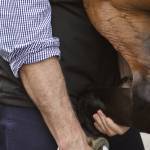Big Ankles in Horses

As a high-motion joint, the fetlock, or ankle, is vulnerable to soundness problems. Lameness or enlargement only of the fetlock joint can occur with inflammation of the soft tissues (ligaments and tendons), cartilage, joint capsule, or bones. The flexor tendons, suspensory ligament branches, and sesamoidean ligaments are found in the rear of the ankle.
Fetlocks endure much stress during exercise. Slow-motion video of a galloping horse reveals that the fetlock drops to at least parallel with the ground and sometimes lower so it appears to touch the ground. This transmits a tremendous amount of force onto the bones, cartilage, and soft tissues of the fetlock joint. Over time and with normal wear and tear, the joint may develop osteoarthritis and lay down more bone surrounding the joint. The tendon sheaths or caudal pouch of the fetlock joint may fill with fluid, a condition called windpuffs.
Diagnosis of the specific cause of fetlock disease includes a thorough lameness examination, radiographs, and ultrasound. Subtle or uncommon injuries may require magnetic resonance imaging (MRI) to make a definitive diagnosis. Arthritic joints are more sensitive to sprains and injury, so affected horses may occasionally need rest, anti-inflammatory drugs, and bandaging to help reduce fetlock pain, inflammation, and swelling.








